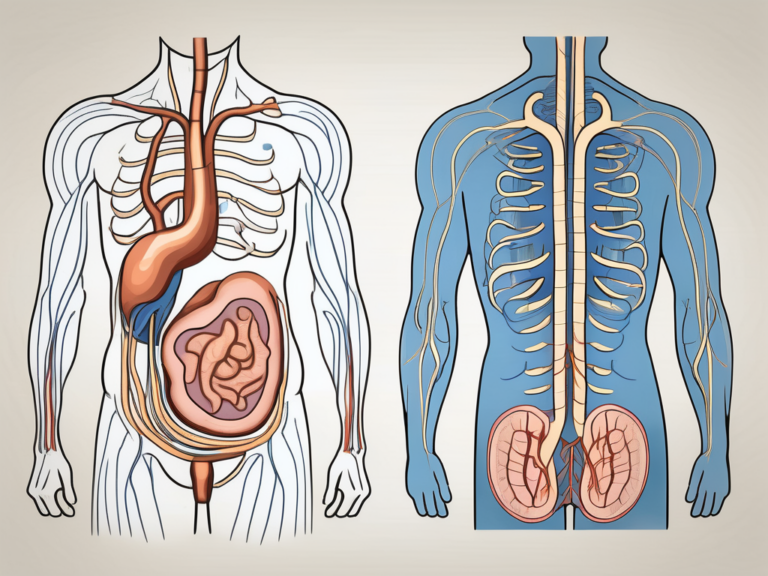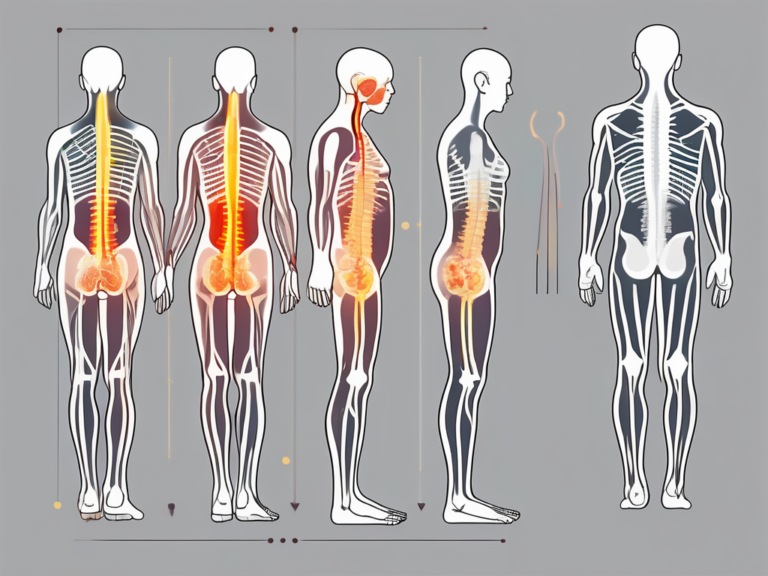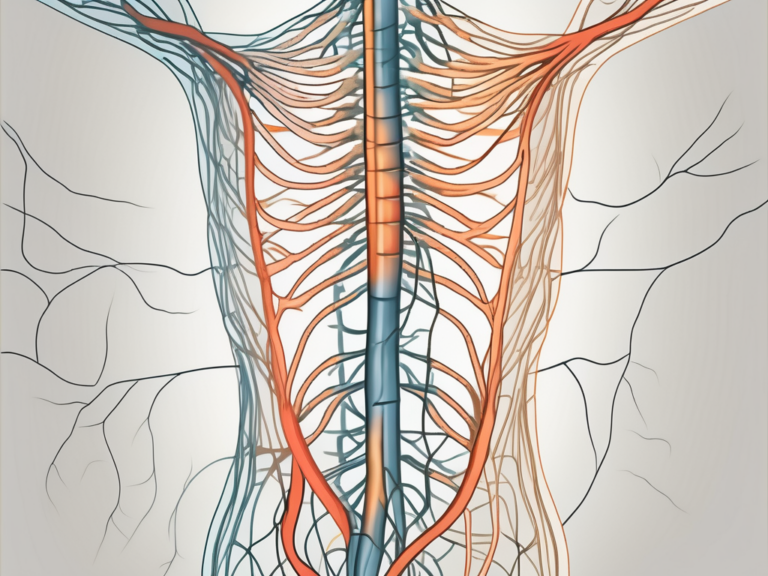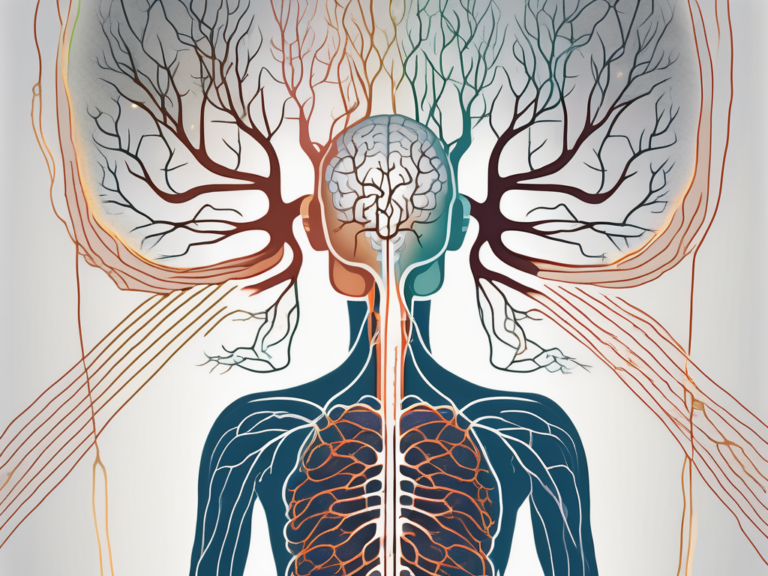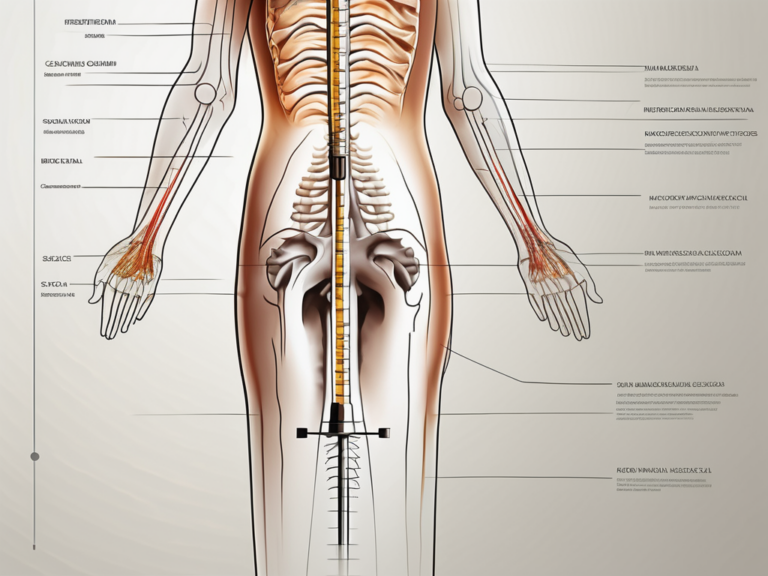What Causes the Sacral Nerve to be Pinched?
The sacral nerve is an important component of our nervous system, responsible for transmitting signals between the brain and various areas of the body. When this nerve gets pinched or compressed, it can lead to discomfort and affect our daily activities. In this article, we will explore the causes, symptoms, diagnosis, and treatment options for a pinched sacral nerve.
Understanding the Sacral Nerve
Before delving into the causes of sacral nerve pinching, it is essential to have a basic understanding of this nerve’s anatomy and function.
The sacral nerve, also known as the sacral plexus, is a complex network of nerves that originates from the lower spinal cord, specifically the sacrum region. It is named after its origin point, the sacrum, which is a triangular bone located at the base of the spine.
The sacral nerve is formed by the merger of several spinal nerve roots, including the fourth and fifth lumbar nerves (L4 and L5) and the first, second, and third sacral nerves (S1, S2, and S3). These nerve roots come together to create a bundle of nerves that extend down the pelvis and into the lower extremities.
Anatomy of the Sacral Nerve
The sacral nerve is divided into two main branches: the anterior division and the posterior division. The anterior division contains motor fibers that control the muscles in the pelvic region, including the bladder, bowel, and sexual organs. The posterior division contains sensory fibers that transmit sensations from the lower extremities to the brain.
Within the sacral nerve, there are also smaller branches that innervate specific muscles and areas of the body. These branches include the pudendal nerve, which controls the muscles of the pelvic floor, and the sciatic nerve, which is the largest nerve in the body and provides sensation and motor control to the back of the thigh, calf, and foot.
Function of the Sacral Nerve
The sacral nerve plays a crucial role in controlling various bodily functions, including bowel and bladder control, sexual function, and sensation in the lower extremities. It is responsible for transmitting signals between the brain and the pelvic organs, allowing for voluntary control of urination, defecation, and sexual arousal.
In addition to its role in motor control, the sacral nerve also carries sensory information from the lower extremities to the brain. This allows us to perceive sensations such as touch, temperature, and pain in our legs, feet, and pelvic region.
Furthermore, the sacral nerve is involved in the autonomic nervous system, which regulates involuntary functions such as blood flow, digestion, and the release of hormones. It works in conjunction with other nerves and structures in the body to maintain homeostasis and ensure the proper functioning of our vital organs.
Overall, the sacral nerve is a complex and vital component of our nervous system. Its intricate anatomy and multifaceted functions make it an essential part of our everyday lives, influencing everything from our ability to control bodily functions to our experience of sensation in the lower body.
Common Causes of Sacral Nerve Pinching
Sacral nerve pinching, also known as sacral nerve compression, can occur due to various factors, ranging from physical injuries to degenerative conditions and even tumors or cysts in the vicinity of the nerve. Understanding the causes of sacral nerve pinching is crucial for proper diagnosis and treatment.
Physical Injuries and Trauma
Accidents, falls, or traumatic events can lead to sacral nerve compression. Injuries such as fractures or dislocations in the pelvic region may put pressure on the nerve, causing it to become pinched. The forceful impact from these incidents can disrupt the normal alignment of the bones and tissues surrounding the sacral nerve, resulting in compression and subsequent symptoms.
For instance, a fall from a significant height can cause a fracture in the pelvis, leading to misalignment of the bones. This misalignment can then put pressure on the sacral nerve, causing pinching and resulting in pain, numbness, or weakness in the lower back, hips, or legs.
Similarly, a car accident can cause sudden jolts or twists to the body, resulting in pelvic fractures or dislocations. These injuries can directly affect the sacral nerve, leading to compression and the associated symptoms.
Degenerative Conditions
As we age, our bodies undergo natural wear and tear. Degenerative conditions, such as arthritis or spinal stenosis, can cause the discs and bones surrounding the sacral nerve to deteriorate. This, in turn, may result in nerve compression.
Arthritis, a condition characterized by inflammation of the joints, can affect the sacroiliac joint located in the pelvic area. Over time, the inflammation can lead to the breakdown of cartilage and the formation of bone spurs. These changes can narrow the space around the sacral nerve, leading to compression and the development of symptoms.
Spinal stenosis, a condition characterized by the narrowing of the spinal canal, can also contribute to sacral nerve pinching. When the spinal canal narrows, it can put pressure on the nerves, including the sacral nerve, leading to compression and the associated symptoms.
Tumors and Cysts
In rare cases, tumors or cysts may develop near the sacral nerve, leading to compression. These growths can exert pressure on the nerve, affecting its normal functioning.
Tumors can be either benign (non-cancerous) or malignant (cancerous). When a tumor develops near the sacral nerve, it can grow in size and compress the nerve, leading to symptoms such as pain, numbness, or muscle weakness.
Cysts, on the other hand, are fluid-filled sacs that can develop near the sacral nerve. These cysts can grow and put pressure on the nerve, causing compression and the associated symptoms. The exact cause of cyst formation near the sacral nerve is not always clear, but they can be related to underlying conditions or genetic factors.
It is important to note that while tumors and cysts near the sacral nerve are rare, they should not be overlooked. Prompt medical evaluation and appropriate treatment are necessary to address these conditions and alleviate the associated symptoms.
Symptoms Indicating a Pinched Sacral Nerve
When the sacral nerve is pinched or compressed, it can produce a range of symptoms that vary from person to person. Understanding these symptoms can help in identifying and treating the condition effectively.
Pain and Discomfort
One of the most common symptoms of a pinched sacral nerve is pain and discomfort. The pain can be localized around the lower back, buttocks, hips, and may extend down to the legs and feet. This pain can be described as a dull ache, sharp stabbing sensation, or a burning feeling. The intensity of the pain can range from mild to severe, and it may worsen with certain movements or prolonged periods of sitting. It is important to note that the pain may not always be constant and can come and go.
In addition to the pain, individuals with a pinched sacral nerve may also experience muscle stiffness and tightness in the affected areas. This can further contribute to discomfort and limited mobility.
Sensory Changes
Pinched sacral nerve can also cause sensory changes in the affected areas. This may manifest as numbness, tingling, or a “pins and needles” sensation in the lower extremities. These sensations can be intermittent or constant, and they may be more pronounced during certain activities or positions. It is important to pay attention to these sensory changes as they can provide valuable information about the location and severity of the nerve compression.
In some cases, individuals may also experience hypersensitivity to touch or temperature changes in the affected areas. This heightened sensitivity can make even gentle touch or slight temperature variations feel uncomfortable or painful.
Motor Function Impairment
In addition to pain and sensory changes, a compressed sacral nerve can lead to motor function impairment. This can result in muscle weakness or difficulty in controlling the lower limbs. Individuals may experience difficulty in walking, climbing stairs, or performing activities that require lower body strength and coordination.
Furthermore, the muscle weakness caused by a pinched sacral nerve can also affect balance and stability. This can increase the risk of falls and accidents, especially when walking on uneven surfaces or navigating obstacles.
It is important to note that the specific symptoms experienced by individuals with a pinched sacral nerve can vary depending on the underlying cause and the severity of the compression. Therefore, it is crucial to consult a healthcare professional for a proper diagnosis and personalized treatment plan.
Diagnosis of Sacral Nerve Compression
Diagnosing a pinched sacral nerve involves a comprehensive evaluation of the symptoms, medical history, and various diagnostic tests.
Sacral nerve compression can cause a range of symptoms, including pain, numbness, tingling, and weakness in the lower back, buttocks, and legs. These symptoms can significantly impact a person’s quality of life and ability to perform daily activities. Seeking a proper diagnosis is crucial for developing an effective treatment plan.
Medical History and Physical Examination
Your healthcare provider will inquire about your symptoms, medical history, and perform a physical examination to assess your range of motion, muscle strength, and reflexes. They may also ask about any recent injuries or traumatic events.
During the physical examination, your healthcare provider will carefully evaluate your spine, paying close attention to the sacral region. They may gently palpate the area to identify any areas of tenderness or swelling. Additionally, they may perform specific movements and tests to assess the function of the sacral nerve and surrounding structures.
Imaging Tests
To obtain a clear picture of the sacral nerve and its surrounding structures, imaging tests such as X-rays, magnetic resonance imaging (MRI), or computed tomography (CT) scans may be ordered. These tests can help identify any structural abnormalities, such as fractures, herniated discs, or tumors.
X-rays provide a detailed view of the bones in the sacral region, allowing healthcare providers to assess for any fractures or abnormalities. MRI scans use powerful magnets and radio waves to create detailed images of the soft tissues, including the nerves, discs, and muscles. CT scans, on the other hand, use a combination of X-rays and computer technology to produce cross-sectional images of the body.
These imaging tests are non-invasive and painless, providing valuable information about the condition of the sacral nerve and aiding in the diagnosis process.
Nerve Conduction Studies
In some cases, nerve conduction studies may be performed to assess the speed and quality of nerve signals. This test can help determine the extent and severity of the nerve compression.
During a nerve conduction study, small electrodes are placed on the skin over the sacral nerve. A mild electrical impulse is then applied to the nerve, and the response is recorded. This allows healthcare providers to evaluate how well the nerve is functioning and identify any areas of impaired conduction.
By measuring the speed and strength of the nerve signals, nerve conduction studies can provide valuable insights into the extent of sacral nerve compression. This information is crucial for determining the most appropriate treatment approach.
Treatment Options for Pinched Sacral Nerve
The treatment approach for a pinched sacral nerve depends on the underlying cause, severity of symptoms, and individual patient factors. Pinched sacral nerve, also known as sacral nerve compression, can cause significant discomfort and affect daily activities. It is important to explore various treatment options to alleviate symptoms and promote healing.
Non-Surgical Treatments
In mild to moderate cases, non-surgical treatments may be recommended to alleviate symptoms and promote healing. These treatments aim to reduce inflammation, relieve pain, and improve overall function. Rest is often advised to allow the body to heal naturally. Physical therapy may be prescribed to strengthen the muscles surrounding the sacral nerve and improve flexibility. Pain medication, such as nonsteroidal anti-inflammatory drugs (NSAIDs), may be prescribed to manage pain and reduce inflammation. Hot/cold therapy, involving the application of heat or cold packs to the affected area, can provide temporary relief. Lifestyle modifications, such as avoiding activities that worsen symptoms and maintaining a healthy weight, may also be suggested. Your healthcare provider may also suggest alternatives such as chiropractic care, acupuncture, or massage therapy, depending on your individual needs.
Surgical Interventions
In more severe cases or when conservative treatments fail to provide relief, surgical intervention may be considered. Surgery aims to decompress the sacral nerve and address the underlying cause. The specific procedure will vary depending on the individual case and should be discussed thoroughly with a healthcare professional. For instance, if the pinched sacral nerve is caused by a tumor, surgical removal of the tumor may be necessary. In cases of fractures or other structural abnormalities, surgery may involve repairing the affected area to relieve compression on the nerve. It is important to note that surgery carries its own risks and should only be considered after careful evaluation and discussion with a healthcare professional.
Rehabilitation and Physical Therapy
After surgical or non-surgical treatments, rehabilitation and physical therapy can play a vital role in restoring strength, flexibility, and functionality to the affected area. These therapies may focus on specific exercises, stretches, and techniques to improve mobility and alleviate pain. Physical therapists are trained to create personalized treatment plans based on the individual’s needs and goals. Rehabilitation may involve a combination of exercises to strengthen the muscles surrounding the sacral nerve, improve balance and coordination, and enhance overall function. Additionally, physical therapists may incorporate modalities such as electrical stimulation or ultrasound to further promote healing and reduce pain. The duration and intensity of rehabilitation will vary depending on the severity of the condition and the individual’s response to treatment.
It is important to consult with a healthcare professional to determine the most appropriate treatment plan for a pinched sacral nerve. They will consider factors such as the underlying cause, severity of symptoms, and individual patient factors to develop a comprehensive approach that addresses the specific needs of each individual. By exploring various treatment options and working closely with healthcare professionals, individuals with a pinched sacral nerve can find relief and regain their quality of life.
Prevention Strategies for Sacral Nerve Pinching
While it may not always be possible to prevent sacral nerve pinching, there are steps individuals can take to reduce the risk of developing this condition.
Sacral nerve pinching, also known as sacral nerve compression, occurs when the nerves in the lower back, specifically in the sacrum region, become compressed or irritated. This compression can lead to pain, sensory changes, and motor function impairment. However, by understanding the causes and prevention strategies, individuals can take proactive steps to promote spinal health and reduce the risk of sacral nerve compression.
Regular Exercise and Stretching
Engaging in regular physical activity and incorporating targeted stretches can help maintain flexibility, strengthen muscles, and promote overall spinal health. Exercise not only helps to keep the muscles surrounding the sacral nerves strong but also improves blood circulation, which aids in the delivery of essential nutrients to the nerves. Consult with a healthcare provider or physical therapist to develop an exercise routine suitable for your specific needs and capabilities.
Some exercises that can be beneficial for sacral nerve health include gentle yoga poses, such as child’s pose, cat-cow stretch, and pigeon pose. These poses help to stretch and release tension in the lower back, promoting flexibility and reducing the risk of nerve compression.
Maintaining a Healthy Weight
Excess weight can put additional strain on the spine and increase the risk of nerve compression. Maintaining a healthy weight through a balanced diet and regular exercise can reduce stress on the sacral nerve and lower the likelihood of pinching.
When it comes to maintaining a healthy weight, it’s important to focus on a well-rounded approach. Incorporating a variety of nutrient-dense foods, such as fruits, vegetables, lean proteins, and whole grains, can provide the body with the necessary vitamins and minerals to support optimal nerve health. Additionally, engaging in cardiovascular exercises, such as walking, swimming, or cycling, can help burn calories and promote weight loss.
Proper Posture and Ergonomics
Poor posture and ergonomics can contribute to spinal misalignment and increase the risk of nerve compression. Practicing good posture while sitting, standing, and lifting heavy objects can help maintain the natural curves of the spine and reduce the likelihood of sacral nerve pinching.
When sitting for extended periods, it is important to sit up straight with the shoulders back and the feet flat on the floor. Using an ergonomic chair with proper lumbar support can also help maintain good posture and reduce strain on the lower back. When lifting heavy objects, it is crucial to use proper lifting techniques, such as bending at the knees and keeping the back straight, to avoid unnecessary pressure on the sacral nerves.
In conclusion, a pinched sacral nerve can lead to pain, sensory changes, and motor function impairment. It is essential to consult with a healthcare provider for a proper diagnosis and appropriate treatment options based on individual needs. By understanding the causes and prevention strategies, individuals can take proactive steps to promote spinal health and reduce the risk of sacral nerve compression.
Remember, prevention is always better than cure. By incorporating regular exercise, maintaining a healthy weight, and practicing proper posture and ergonomics, individuals can significantly reduce the likelihood of developing sacral nerve pinching and enjoy a healthier, pain-free life.

